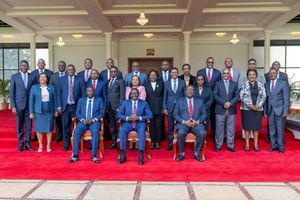
President William Ruto chaired a Cabinet meeting on Thursday morning last week to take stock of the nationwide youth protests that have left a trail of death and destruction.
President William Ruto has borrowed from the 2005 script by late President Mwai Kibaki who fired his entire cabinet after a humiliating defeat at a national referendum in his bid to shore up dwindling public confidence in his administration.
But unlike President Kibaki who lost the vote that scuttled a government-sponsored constitution draft, President Ruto has been forced to act by protests by youths initially sparked by unpopular taxes and extravagance by the elite in the face of economic hardships by the majority.
Dr Ruto’s withdrawal of the Finance Bill 2024, which contained tax proposals to raise an additional Sh350 billion, did little to quell the protests by the Gen Zs who have also complained about governance ills and demanded accountability in how government is run.
In the past, the government had disregarded public opposition to tax increases, even after public hearings, and exploited a ruling coalition majority to shove the unpopular policies down the throats of weary Kenyans, a script it had replayed with the recent Bill after failing to read public mood.
The bloody crackdown by police - at least 39 people have been killed and hundreds injured, infiltration of the protests by goons in an orgy of violence and looting, occasioning economic losses running into billions, meant the crisis could no longer be ignored.
President Ruto first signalled the looming cabinet changes a week ago, committing to “shortly” reorganise his government during an address from State House last Friday as unrelenting protestors piled up pressure on his administration.
A subsequent engagement with the youths on X Spaces proved insufficient to appease the government critics who have warned of more protests, defying State-sponsored terror, including abductions, torture and killings unleashed to try to suppress the demonstrations.
It was the president’s third address since the protests started a month ago, the first on the day demonstrators stormed Parliament, attracting a backlash after the president was accused of failing to show empathy to the families of those killed.
Second address
The second address during which the president sought to assuage bitter Kenyans saw him announce the withdrawal of the controversial tax proposals but his statement on June 27 was marred by a sensational claim by Deputy President Rigathi Gachagua.
Mr Gachagua, who unusually convened a press briefing after the president’s address, claimed the National Intelligence Service boss Noordin Haji had not given a proper brief about the scale of public disillusionment.
This stunning address by the deputy president publicly exposed the deep rifts within the government although the conflict had been raging for some time with Mr Gachagua accusing some of the president’s allies of attempting to demean his office.
Further infuriating demonstrators was the government’s action, on the day President Ruto was backing down on the Finance Bill, to call out the military to the streets, a reaction that questioned the State’s sincerity to negotiate a truce and which only hardened government critics.
Internal strife
Already rocked by internal strife, the protests only further exposed the Kenya Kwanza government’s soft underbelly just two years after storming to power on a populist campaign that promised to uplift the downtrodden and ensure equal access to opportunity irrespective of class.
The initial response to the public revolt that was building up online was a contemptuous dismissal by the president’s allies and advisors, including David Ndii who dared the Gen Zs saying their campaign could not move beyond social media.
It is a line that government functionaries constantly hammered until the crisis snowballed into a huge protest that brought the capital city to a standstill and the world took notice of the revolution that was aided by online mobilisation.
At one point, even the International Monetary Fund (IMF) which has been accused of prescribing harsh policies like more taxes that are hurting Kenyans was forced to declare it was not to blame for the Kenyan government’s actions that had triggered the rebellion.
DP’s tenure is ring-fenced
While the president has made missteps in his response to the crisis, his action today to fire the entire cabinet, apart from his deputy- the DP’s tenure is ring-fenced by the constitution- and Prime Cabinet Secretary Musalia Mudavadi- perhaps for political and diplomatic considerations given his Foreign Affairs portfolio- offers him the opportunity to buy time.
But eyes will be on the new Cabinet appointments and whether they will be a break from the past in terms of the credentials of the appointees and their ability to offer hope that they will run a government that is sensitive to the plight of Kenyans already battered by the runaway cost of living.
The president will also be under scrutiny to ensure a lean government- it is expected he will cascade the crackdown to principal secretaries- that reflects his belt-tightening campaign in the face of the nation’s financial challenges largely attributed to soaring debt and wastage.
This will require a delicate balancing act to deliver considering the talk of a government of national unity, which is interpreted as coopting more opposition members.
The country’s past experience with this has been a bloated government, which will be unacceptable to the public and will further inflame the inferno.






